|
|
|
Sort Order |
|
|
|
Items / Page
|
|
|
|
|
|
|
| Srl | Item |
| 1 |
ID:
127848
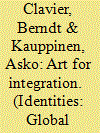

|
|
|
|
|
| Publication |
2014.
|
| Summary/Abstract |
Cities increasingly use artistic and cultural activities to promote active citizenship and social cohesion. We suggest that city-sponsored cultural and artistic practices in Sweden are finding a new discursive context in migration. In this article, we look at two artistic and cultural institutions in Malmö, Sweden: Arena 305 and Drömmarnas hus. We develop a typology of governmentalisation based on the work of Nicholas Rose and Peter Miller, which allows us to describe the governing activity of Arena 305 and Drömmarnas hus. What becomes visible is the discrepancy between the moral form of the political rationalities and the technologies of government: even though institutions may harbour ideals and principles of inclusion, they are perfectly capable of sustaining activities that brighten the very boundaries they set out to challenge.
|
|
|
|
|
|
|
|
|
|
|
|
|
|
|
|
| 2 |
ID:
127847
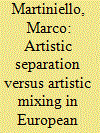

|
|
|
|
|
| Publication |
2014.
|
| Summary/Abstract |
This introductory article discusses the diversification of diversity in Europe. It then looks at the tension between ethnic separation and ethnic mixing in urban Europe in general terms. The next section elaborates on a similar tension in the field of popular arts. Finally, the article presents the main insights of the contributions to the special issue.
|
|
|
|
|
|
|
|
|
|
|
|
|
|
|
|
| 3 |
ID:
127852
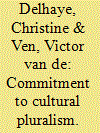

|
|
|
|
|
| Publication |
2014.
|
| Summary/Abstract |
Cultural policy has traditionally had close ties with the construction of the society as a nation state, which has been marked by its built-in tendency towards cultural homogenisation. Post-World War II, multicultural societies pose profound challenges to these traditional forms of cultural policy. Although, in the last decades, western democracies have been designing cultural diversity plans, this does not mean that governmental policies have successfully been translated in institutional practice. In the Netherlands, mainly established cultural institutions have failed to integrate diversity into their core business. Yet, there have been a few exceptions that continue to make attempts to adapt their programmes to address new populations. In this article, we use Parekh's view of a multiculturalism that reconciles unity and diversity, as a heuristic device that allows us to explore and examine the bottom-up diversity policies and practices of two Amsterdam-based cultural institutions: Paradiso and De Meervaart.
|
|
|
|
|
|
|
|
|
|
|
|
|
|
|
|
| 4 |
ID:
127849
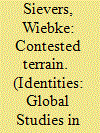

|
|
|
|
|
| Publication |
2014.
|
| Summary/Abstract |
Culture in Vienna has become more diverse with successive waves of immigration since the 1960s, but Austrian cultural policies have been slow in picking up this trend. While the federal state has been focusing on maintaining traditional cultural institutions in Vienna such as the Staatsoper, the Burgtheater and the Kunsthistorisches Museum, the city of Vienna has pushed integration and later diversity in cultural policies since the 1990s, albeit more in discourse than in actual funding. Artists of immigrant origin harshly criticise this dire situation: they claim the place which they have not yet been granted, not only in cultural policies, but also in society.
|
|
|
|
|
|
|
|
|
|
|
|
|
|
|
|
| 5 |
ID:
127853


|
|
|
|
|
| Publication |
2014.
|
| Summary/Abstract |
The present article contributes to the ongoing academic debate on migrants' appropriation of artistic and political spaces in Germany. Cologne, one of the largest cities in Germany, is an interesting example of the tension between political discourse centred around multiculturalism and cultural segregation processes. The 'no fool is illegal' carnival organised by asylum seekers shows their capacity to act, as they reinvent an old local tradition by reinterpreting medieval rituals. Today, different groups and associations appropriate this festive art space: migrants, gays and lesbians, feminists and far-left groups either organise their own parties or take part in the official parties and parades as separate groups. As a result, the celebration of diversity figures on the local political agenda and becomes part of the official carnival festivities. This leads to a blurring of boundaries, whereby mainstream popular culture becomes more and more influenced by multicultural elements.
|
|
|
|
|
|
|
|
|
|
|
|
|
|
|
|
| 6 |
ID:
127851


|
|
|
|
|
| Publication |
2014.
|
| Summary/Abstract |
This article looks at the emergence of the Murga in Antwerp. In the city of Antwerp, diversity has become a polarising characteristic of the city. This contribution about the Murga illustrates how art, as the symbolic manifestation of culture, favours integration and social cohesion. Before discussing whether the Murga is actually doing this, we shall examine how the Murga became an example of policy attempts to understand and govern diversity, which is of key importance in developing efficient strategies for enhancing social cohesion. From the policy intention regarding participation and social cohesion, we see how achieving a new shared cultural identity across ethnic groups requires a cultural hybridisation.
|
|
|
|
|
|
|
|
|
|
|
|
|
|
|
|
| 7 |
ID:
127850
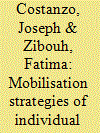

|
|
|
|
|
| Publication |
2014.
|
| Summary/Abstract |
Though sharing a common territory, the cultural spaces of Brussels are divided according to a complex structure where Francophone and Flemish Communities play a dominant role. These two language-based communities set separate cultural policies and programming for their residents in Brussels. Within this fragmented structure, local socio-cultural actors have mobilised promoting cross-Community collaboration towards a shared vision for the Brussels-Capital Region (ex. Cultural Plan for Brussels). Further, individual artists themselves have developed strategies to participate in Community-defined cultural programming and to gain recognition for their talent as local (Bruxellois) artists regardless of their ethnic, linguistic or migrant background. This article explores how socio-cultural actors and artists have mobilised to reframe 'culture' in Brussels, and to gain access to cultural venues particularly in the case of migrant and migrant-origin artists whose engagement and recognition in Brussels' cultural scenes have been little studied.
|
|
|
|
|
|
|
|
|
|
|
|
|
|
|
|
|
|
|
|
|